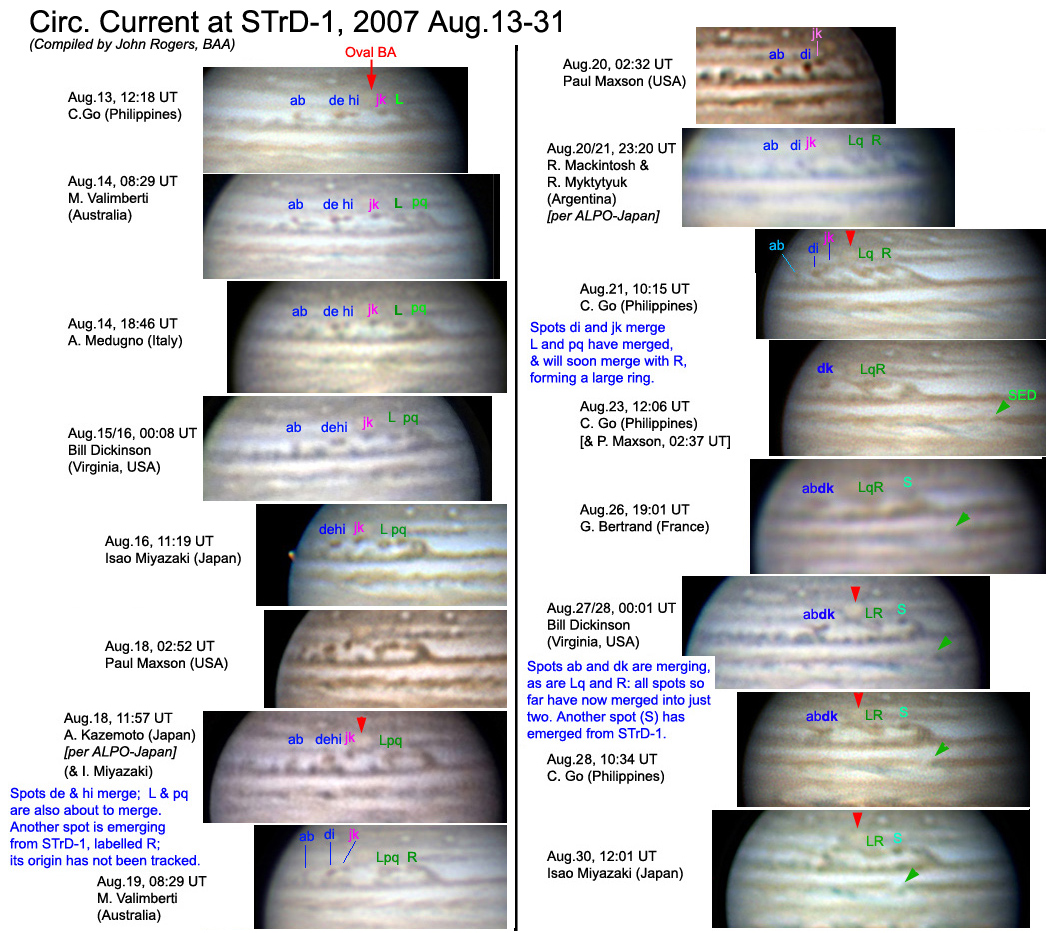
[18] Circulating current report and images, August 13 - September 27; & Description of the planet, 2007 Aug.-Oct. (2007 Dec.)
(1)
The Circulating Current, Aug-Sep.
See
montages
posted below.
Recirculation
and mergers of the jetstream spots continued.
On Aug.18, spots de and hi merged (forming di); over the next 2 days,
spots L and pq also merged. Meanwhile another large spot was emerging from
STrD-1, labelled R. (R is capitalised to indicate that I have note tracked its
origin; it could also have resulted from merger of earlier spots, as all the
previous spots did.) On Aug.23,
spots di and jk merged (dk). By
Aug.27-28 it appeared that spots ab and dk were merging, as were spots Lq and R;
thus 16 of the 17 spots formed so far (except small spot c) had recirculated
onto STBn and merged into just two complexes.
This process can also be followed on the JUPOS chart, which shows that
the recirculated spots typically prograded at DL2 ~ -2.0 to -2.5 deg/day, but
spots ab, de, and L all decelerated markedly, and this led to their apparent
mergers with the spots following them in turn.
However
these last mergers (ab-dk and Lq-R) did not produce stable outcomes.
On Sep.1-4 they had broken up again into strings of small spots. One
small very dark spot, resulting from the ab-dk merger, was almost stationary in
the middle of the STropZ at L2 = 262 (Aug.30 – Sep.14). Some small dark spots
were still prograding past it on STBn at ~-2 deg/day.
Subsequently, long gaps between good images make it impossible to track
such features, but there were no large coherent spots on STBn. However STrD-1
remained as large and dark as ever, at least up to Sep.26.
On
SEBs, the retrograding dark pots after L were crowded and difficult to follow.
The JUPOS chart shows clear tracks which can continue the original numbering up
to t, u, v, up to late August, but thereafter the SEBs spots were indistinct.
Many of these spots were only modestly retrograding at first but accelerated in
the retrograding direction to attain the full jet speed of about +4.0 deg/day.
(This was the exact speed of the first spot, and also the mean speed of
these spots, +120 deg/mth; individual spots varied from this by +/-
8 deg/mth, but there was no systematic change in speed as the Revival
progressed.)
The
September images show a densely spotty SEB(S) with a few distinct bright spots
on SEBs.
(2)
Description of the planet
This
applies throughout 2007 September & up to mid-October, unless otherwise
stated. Few images were recorded after September, and almost none after
mid-October, even though the planet was still quite high in the evenings in the
southern hemisphere!
See
montages inc. [STrD1_Sept., SED_2007Sept., & Set-for-JBAA_2007Sept.]
STB:
Oval BA has a dark rim. The red colour in oval BA has faded, but is still
present as of Sep.23 and Oct.29.
The
STB is a broad dark belt p. and f. BA, in Sept. – presumably formed from dark
material of the recirculated spots. It
has a tapered p. end, and a f. end continuous with STrD-1 in Sep.; then in Oct.
it seems to be have detached from STrD-1.
STropZ:
See above re Circulating Current. STrD-1
remained prominent and dark into October, even though the recirculating activity
was less conspicuous after Sep.1. STrD-2
still existed too, thru Sep. & into Oct., still just a small hump and wisp.
SEB(S)
retrograding spots are smaller and less distinct in Sep., so cannot be clearly
tracked thru the Circ. Current.
SEB:
Double at all longitudes. SEBZ is
white p. GRS, shaded (turbulent) f. GRS.
F. GRS, in the source region of the Revival, there is still much
disturbance but only small-scale. P.
GRS, the SEB(S) is dark right up to the RSH.
GRS
has not faded; although the N half is paler than the rest, it is still a
distinct dark orange oval.
So
the anticipated fading of GRS and reddening of SEB have not yet occurred.
SED:
In August and early Sept. it had the classic appearance of a main complex
with rift in SEB(N), preceded by a stormy sector. It was passing STrD-1 in early Sept. After that it appeared more irregular, tho the large white
area at the main complex, with some dark blue-grey spots p. it, were still quite
conspicuous. It passed the GRS on Aug.1, and again around Sep.25.
There were no good images of it after Sep.27.
EZ:
The exceptional dark grey-brown shading of the first half of the year,
including the broad EB and festoons, were all fading, i.e the EZ was lighter
again. This was already noted in July and the trend clearly continued in Aug.
and Sept.
NTB:
Strongly reddish after its revival -- orange-brown at all longitudes.
NTropZ,
NTZ:
Light, no strong colour.
___________
John
Rogers
BAA
Jupiter Section Director
___________________________________________________________________________


